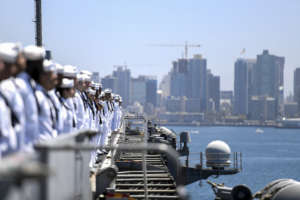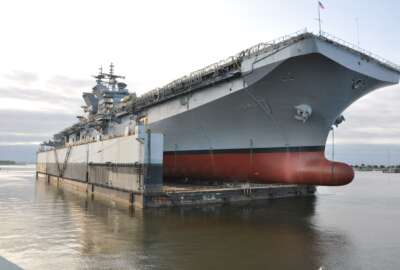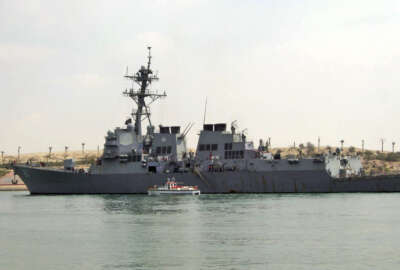
Exclusive
355-ship fleet means more than plans to build ships, Kaine says
Senate Armed Services Member Tim Kaine says the Navy needs a plan for the shipbuilding and repair workforce.
Best listening experience is on Chrome, Firefox or Safari. Subscribe to Federal Drive’s daily audio interviews on Apple Podcasts or PodcastOne.
The Navy is still planning to build its fleet to 355 ships in the next 30 years, but in order to do that Senate Armed Services Committee member Tim Kaine (D-Va.) said the government needs better planning to take on the herculean task.
The Navy already has a plan for getting to 355 ships, which Kaine said is adequate, but the means to get there are not as well arranged. Building about 70 new ships requires beefing up the shipbuilding personnel pipeline and figuring out how to keep ships lasting longer.
“We don’t even have a completely solid estimate of the workers we are going to need over the next 20 years to do this,” Kaine told Federal News Radio in an exclusive June 12 interview. “Often the ship builders and the ship repairers, they trade workers back and forth but they don’t plan a lot together. You might work for a private shipyard and then leave to go work for a shipbuilder or vice versa, but they’re not sitting down and planning together, talking about what the comprehensive need is going forward.”

That’s a particular concern when the shipbuilding and repairing workforce continues to age. The shipyard in Newport News, Virginia has 1,000 workers who have been there more than 40 years.
There’s going to be some retirements and they have to factor that in too.
“We have to get an overall picture of what the need will be going forward,” Kaine said.
Kaine said he wants to help push and encourage the shipbuilding region to create a comprehensive assessment of the age of their workers. During a June 8 meeting with Kaine, shipbuilders, companies and military officials, Huntington Ingalls offered to convene a meeting between shipbuilders and ship repairers to put precision on what the community needs over the next 30 years.
“The shipbuilders and ship repairers, probably with the Chambers of Commerce as kind of stakeholders, I think they are now moving out to identify what the regional need is and frankly shipbuilding communities all over the country need to do the same thing,” Kaine said.
Vice Adm. Thomas Moore, chief of Naval Sea Systems Command (NAVSEA), said last year his command’s shipbuilding and acquisition forces need to grow in order to handle the demands on Navy ships.
NAVSEA saw 2,000 more civilian hires in 2017 to deal with the repair maintenance backlog.
To help hire and draw in shipbuilders and repairers, Kaine said the Senate Health, Employment, Labor and Pension Committee will likely reauthorize the Perkins Act, which helps fund career and technical education and the Higher Education Act, which deals with the training of engineers and other professionals who work on ships.
Latest Defense News
Kaine said he’d be keeping shipbuilders and repairers in mind when working on those bills.
“Why can’t you use Pell grants in career or technical or apprenticeship programs. We ought to be able to expand Pell grants to do it and we will take up the Pell grant question as part of the Higher Education Act,” Kaine said.
It’s not just the shipbuilders and repairers that the Navy might be short.
“My gut tells me over the last five or six years that the wave of sequester, furlough, budget caps, flirting with shutdown, et cetera, has hit our acquisition workforce very hard. They often feel they could do better elsewhere. If you’re going to build up you’ve got to have people that really know how to work on acquisitions to contract smartly, do it quickly, manage to budget and timeliness and so we have to pay attention to that element of the workforce,” Kaine.
He added the Senate Armed Services Committee will have to devote effort to that sector of the workforce in future defense authorization bills.
Maintenance
Outside of the workforce, Kaine says the Navy needs a better plan for making ships last.
“We don’t have a ship repair plan. One of the ways you get to 355 is you maintain your ships well enough to give them a maximum service life and if you don’t maintain them, well, then they get obsolete too soon and you can’t meet your goal,” Kaine said.
Kaine talked about the Navy’s chief acquisition officer James Geurts’ idea to develop a 30-year ship repair plan that is as specific as the ship building plan.
Kaine said he is excited to work with the Navy and put pressure on them to create a ship repair plan.
Copyright © 2024 Federal News Network. All rights reserved. This website is not intended for users located within the European Economic Area.
Scott Maucione is a defense reporter for Federal News Network and reports on human capital, workforce and the Defense Department at-large.
Follow @smaucioneWFED





